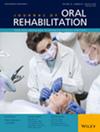Characteristics of Temporomandibular Joint Osteoarthritis Patients With Condylar Erosion: A Retrospective Cross-Sectional Study
Abstract
Background
Condylar erosion (CE) may indicate an active progressive stage of temporomandibular joint osteoarthritis (TMJOA), but no studies have analysed the characteristics of this population.
Objective
This cross-sectional study analysed the characteristics of TMJOA patients with CE.
Methods
A total of 267 patients were included. The severity of CE of all joints was evaluated using cone beam computed tomography (CBCT) and scored using a four-point rating scale (0–III). Patients were categorised into mild (grade I), moderate (grade II) and severe (grade III) groups. Demographic and clinical characteristics were summarised and stratified by age and erosion severity. Univariate and multivariate logistic regression analyses were performed based on the assignment of the variables.
Results
The proportion of patients under 30 years old is much higher than other age groups. Compared to adults (≥ 20 years old), a higher proportion of adolescent patients (10–19 years old) choose orthodontics department for their first consultation (p < 0.01). And adolescent patients have a higher proportion of temporomandibular joint (TMJ) noise (p < 0.05) and a lower proportion of arthralgia (p < 0.001). Significant differences exist in CE severity between adolescents and adults (p < 0.001). The severe group had the youngest patients (p < 0.05) and the highest proportion of mandibular deviation and abnormal postural habits.
Conclusions
Patients under 30 years of age constitute a significant proportion of TMJOA cases with CE. Compared to adults, adolescent patients have more severe CE and less arthralgia. Due to obvious dental and maxillofacial deformities and milder TMJ symptoms, adolescent patients may not be aware that they have TMJ disease, potentially leading to delayed treatment.


 求助内容:
求助内容: 应助结果提醒方式:
应助结果提醒方式:


